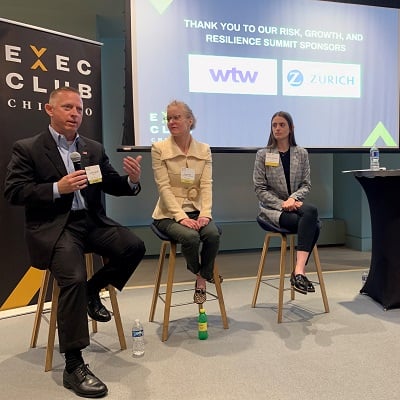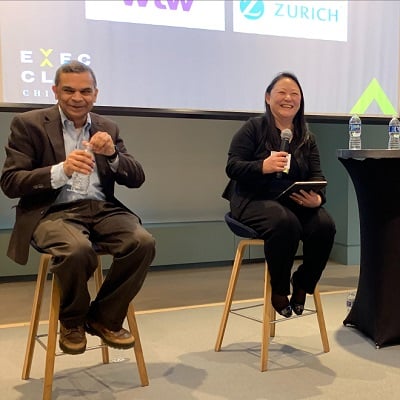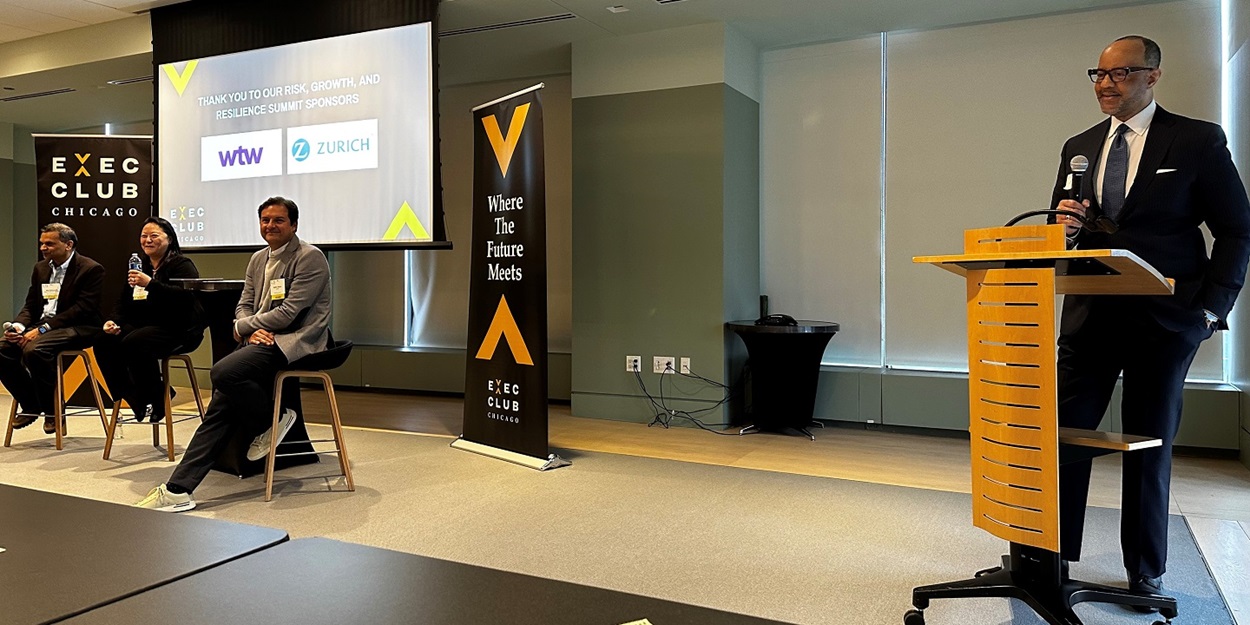Climate, cyber and AI insights emerge from Chicago risk summit
Technology and AIArticleMarch 18, 2024
Storm clouds outside the world-famous Willis Tower could have cast a dark mood over the very first Risk, Growth, and Resilience Summit presented by The Executives' Club of Chicago and co-sponsored by Zurich North America and WTW. Instead, executives including Zurich North America’s Chief Risk Officer Ann Chai joined leaders from several Chicago organizations in highlighting the bright spots on the risk landscape — along with key challenges.
Focusing on climate change, cyber threats and the unknowns of artificial intelligence (AI), leaders from Zurich and WTW exchanged insights with experts from ComEd, Argonne National Laboratory, First Women's Bank and Climate Resilience Consulting. Panelists in three sessions, including Zurich North America’s Chief Data and Analytics Officer Jane Rheem and Zurich Resilience Solutions’ Head of Cyber Jarrett Kolthoff, also took questions from the audience.
Compound risks – and the opportunities to build resilience to them – were a thread through the discussions. Compound risks refers to an intersection of consequential risks, such as the prospect of a cyberattack paralyzing a hospital or utility grid during a life-threatening heat wave.
In the summit’s opening session, Chai referred to the World Economic Forum’s 2024 Global Risks Report, of which Zurich is a supporting partner. She acknowledged that the risks therein, including the rise of misinformation and disinformation, can seem overwhelming to address.

But there’s precedent for organizations successfully confronting daunting risks, Chai said. She pointed out that the risk summit coincided with the week that is widely regarded as the fourth anniversary of the pandemic shutdown.
“When the world shut down in a way that it had never before, we were able to come together,” Chai said. “Yes, there was a lot of loss and hardship, but that was a short four years ago, and we came out of that, not because there was a magic bullet and certainly not because we were aligned on the best approach, but by doing what we can to move forward.”
Similarly, there’s no single solution for climate risk and cyber threats.
“We can’t wait for perfection to make incremental progress,” Chai said in her discussion with Amy Fahey, Chair of the Board of First Women’s Bank. “The question is, what can we pragmatically do?”
Chai and other panelists offered key insights to help address that question.
In the “Future Risks in Focus: Chicago Edition” session, Kolthoff was joined by Joyce Coffee, President of Climate Resilience Consulting, and Rebecca Kartheiser, Reliability Inspection Engineer for ComEd, in a discussion moderated by Tom Wall, Director of Climate Resilience and Decision Science at Argonne Laboratory.
What is a key gap in business cybersecurity?
Cyber risk and climate risk may not seem intuitively connected, Kolthoff said, but businesses and infrastructure, which millions of Chicagoans count on, are vulnerable to both.

In 2005, after working in Army counterintelligence, Kolthoff founded the cyber counterintelligence firm SpearTip, which was acquired by Zurich last year. Back then and now, Kolthoff said, one of the greatest threats to cybersecurity is inadequate investment. C-suite and board leaders may delegate cybersecurity to technically focused teams that do not necessarily have the business acumen to advocate for the budget allocations needed, so the funding doesn’t come.
“When the bad event happens, they are not well prepared,” Kolthoff said. “That’s often when our team is called. They don’t like to see us, but they’re glad they we’re there, because we turn a really bad day hopefully into just a bad few days, not months.”
He recommends organizations practice cyber threat preparation and response by engaging in realistic cyberattack simulations.
“In the military we say you have to train like you fight,” Kolthoff said. “If you’re not training, you’ll never identify your gaps.”
Preparing for the threat reveals its value in the event of a ransomware attack, he said. Even if an organization pays the ransom, restoration of large files or complex datasets rarely occurs, he said.
“Most organizations have either been compromised or are currently compromised and don’t know it,” he added. “It’s just a matter of when it’s going to happen, when the threat actor decides it’s time.”
Insurance is one piece of the protection puzzle. “Make sure you have social engineering coverage,” he said. “Make sure you’re not relying on your crime policy when responding to a business email compromise and wire fraud.”
How can businesses balance AI’s potential and hype?
In an AI-focused session, Zurich’s Jane Rheem exchanged thoughts on the risks, opportunities and hype around advanced technologies with Rao Kotamarthi, Science Director of the Center for Climate Resilience and Decision Science at Argonne National Laboratory. Delfin Viloria, Director of Risk Consulting & Analytics at WTW moderated the discussion. Al Orendorff, Chief Communications Officer at Zurich North America, introduced the panel.

Rheem pointed out that the insurance industry, which tracks and processes copious amounts of data for risk prediction, has been using machine learning for years to assist in analytics that go into pricing and risk selection by Zurich team members.
More recently, Zurich has been using generative AI to create economic value through productivity improvements, assisting knowledge workers with repetitive and mundane tasks.
“It’s about human augmentation, it’s not to replace people,” Rheem said. “You can’t replace human judgment; that’s still really critical. However, it doesn’t mean we can’t use large language models to help with productivity. By removing tasks that no one wants to do, we can enable them to focus on their human value-add beyond what a machine can do.”
Kotamarthi cited an example of how Argonne has been using AI, to build a weather forecasting model whose accuracy so far is rivaling another model they use. This has the potential to improve calculation of the risks associated with climate change and weather.
“AI is changing my world and I think it will change your world in ways you have not yet imagined,” Kotamarthi said to the audience.
Both Rheem and Kotamarthi said a big focus with building AI models is trying to reduce the potential for bias and hallucination, where the model produces a result that seems factual but is not.
Kotamarthi said a weather forecasting model, for example, must take into account different resource levels in communities so that weather impacts aren’t underrepresented. Lower-income areas of Chicago, for example, may be more susceptible to negative impacts of higher temperatures because air conditioning may not be as prevalent in homes and infrastructure may be older.
“We have to make sure models are fair to everyone,” Kotamarthi said. “Everybody should be aware and try to have a voice in how models are developed. Models will determine how we live 10 years down road.”
Insurance regulators also are taking steps to address the risk of algorithmic bias, which is an area of particular concern in personal insurance. Zurich North America is primarily a commercial insurer but is still diligent about avoiding the creation or use of models that could generate flawed data.
ChatGPT and large language models have many limitations, Rheem pointed out; for example, ChatGPT is not designed to perform mathematical calculations. “The AI we have is still single threading not multithreading,” Rheem said. “True AGI [artificial general intelligence] is a mind of its own, literally a mind of its own. We are very far from there. We need to have massive yet unknown breakthroughs to even get close to that.”
Kotamarthi said he thinks progress could be swift. For example, work is under way to build a GPT for science, which could be transformative in his work.
To balance possibilities with reality, Rheem said she tries to be laser-focused on business objectives.
“There is so much hype around AI,” Rheem said. “I work hard to take a practical approach and refrain from thinking about tech for the sake of tech. Technology is a means to an end. We’re here to enable the strategic objectives of the company. Everything must have a purpose. But also we must have the flexibility to experiment. Taking a very agile approach is critically important. You will fail a lot more times than you succeed. It’s those failures that build success and build maturity.”
A snapshot of Chicago’s climate advantages
Focusing locally, Coffee in her session shared some of the advantages that Chicago has for climate change adaptation and mitigation. Her organization, Climate Resilience Consulting, has collaborated with organizations such as WTW on climate transition strategies.
- “We have an extraordinary, adequate supply of fresh water for the population,” Coffee said. “The Great Lakes are just an amazing resource and we are continuing to be careful with them, more than many other parts of the world where they sully their freshwater resources.”
- Wildfire and tornado risk also relatively low in the Chicago region, she said, and temperatures are relatively moderate, which helps with infrastructure resilience.
- Flood risk has improved in many areas of Chicagoland thanks to The Deep Tunnel system investments over the past couple decades, she added. But some lower-income areas on the South and West Sides of the city have experienced underinvestment in flood mitigation and climate change resilience. There are many equity issues to consider and address in the climate transition, she said.
- Coffee added that being in the so-called “Rust Belt” equips Chicago with some legacy resources that could become resilience advantages. “We have the potential to be part of that transition because we can make more efficient things with better technology,” Coffee said. “There is a trained workforce, including in our utilities, that are ready to take on the renewable industry, the electric vehicle industry, the high-efficiency air conditioning industry and many other things that are really needed to be part of that transition.”
Overall, she said, Chicago can be a leader in the climate transition.
“We will be the home for people retreating out of harm’s way. We are really very much in a better position than many other communities in America,” she said. “I’m really really bullish on Chicago as a place for climate action, climate solutions and, really, climate safety for the United States.”
